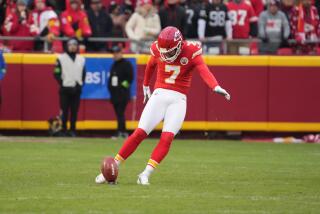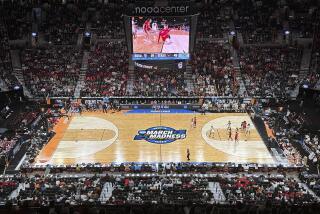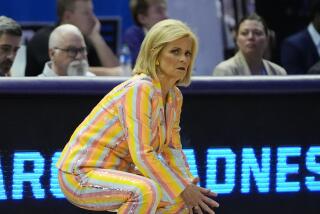THE GREAT THREE-POINT SHOT DEBATE : Will It Open Up the College Game, or Is It Just a Drop in the Bucket? Here Are Two Views of the New Rule : WHY ITâS GOOD FOR THE GAME
Three cheers for the three-point shot.
The decision of the NCAA menâs basketball rules committee to award three points for shots made from 19 feet 9 inches and beyond gives the ball to the people you pay to see, the players, and takes it away from the coaches.
Is it any wonder that 64% of the coaches surveyed by the NCAA are against it?
Those are the coaches who teach by the book. You can tell the book by its worn-out cover.
According to the book, the primary offensive strategy is to get the ball close to the basket, preferably into the hands of the tallest player, for the least challenging shot possible.
To defend against this, the book says, put as many men as possible close to the basket to prevent the ball from getting there.
And if the ball gets there anyway?
Hack the man who has it until he either gives it up or until a whistle blows.
How exciting.
Coaches call this percentage basketball.
Almost everyone else who watches calls it predictable.
So the rules committee, despite the objections of the coaches, drew the line and invited players to shoot from behind it.
âWhat everyone has to remember is the game does not belong solely to the coaches,â said Ed Steitz, a Springfield College professor who is secretary-editor of the rules committee.
âIt belongs to the fans, players and the media, as well. We expect the rule to add a new excitement and flavor to the game.â
The rules committee took one step in that direction before last season with the addition of the 45-second clock, which forced teams out of their four corners and into full, 40-minute games.
Many coaches didnât like that rule either, because it took control of the game away from them, especially in the final minutes, and forced them to let the players play.
But it also made the games more interesting, which, like it or not, also will be a result of the three-point shot.
âI think the three-point field goal is ideal with the 45-second clock,â said UC Irvineâs Bill Mulligan, a minority voice among coaches.
âIâm for anything that opens the game up. We are in the entertainment business.â
In favor of the three-point shot, here are three points:
--There will be fewer elbows and more elbow room under the basket.
There have been other suggestions for uncluttering the middle, including widening the lane and even widening the floor.
The former wouldnât be effective because defensive players still could camp under the basket, and the latter would be too costly.
The three-point shot encourages outside shooting, thus discouraging zone defenses that clog the lane and turn what is supposed to be a noncontact sport into a rugby scrum.
--Fewer games will be over until theyâre over.
That was evident in the World Championships last July in Spain, where the Soviet Union almost overcame the United Statesâ 18-point, second-half lead because of superior outside shooting. The International Basketball Federation adopted the three-point shot from 20-6 after the 1984 Summer Olympics.
Teams with large leads, formerly known as comfortable leads, no longer can play ultraconservatively in the final few minutes because, with timely outside shooting, their opponents can get back into games so quickly.
Also, teams that are behind wonât have to start sending their opponents to the free-throw line quite as early as they did in the past in order to have a chance to come back.
--There will be a return of the shooting stars.
There has been talk for years about de-emphasizing the role of the big man. Some have suggested raising the basket. Coach Abe Lemons of Oklahoma City University has suggested putting the goal in the floor, which he said would encourage the recruiting of midgets.
This new rule does not take the big man out of the game. In fact, it should give the big man even more room near the basket as defenses spread out to guard against three-pointers. But the new rule does give the little man a shooting chance.
Spud Webb and Tyrone Bogues notwithstanding, most coaches have gone to taller lineups. That includes guards, not because coaches want them to be able to shoot over defenses but because coaches want them to be able to pass over defenses. Percentage basketball, remember.
Because of the three-point shot, it will be to the coachesâ advantage to have players who are accurate from outside, whether theyâre 6-9 or 5-9. Coaches may even begin recruiting long-shot specialists as shooting again becomes an art instead of a last resort when the clock is running out.
In the new reality, Reggie Miller will be as important to a team as Patrick Ewing.
Speaking of Miller, UCLAâs zone buster, he said there was a party at his house when he discovered the three-point line was only 19-9 from the basket.
That may indeed be too close, which even the rules committee admits. Steitz said that the NCAA will try it from that distance for a year and then make the necessary adjustments.
Thatâs not to say thereâs nothing to shooting from 19-9. In the two conferences that experimented with the three-point shot last season, the Big Sky and the Pacific Coast Athletic Assn., the long-range bombers shot 39%. Thatâs a good number, enticing but not a gimme.
The PCAA has used the three-point shot three of the last four seasons. Of its 10 coaches, 6 favor the new rule.
One of them, Utah Stateâs Rod Tueller, said coaches will become fonder of the rule--if they have good three-point shooters.
And if they donât have someone like Miller or Steve Alford of Indiana?
âIâll admit Iâve lost some games because of the three-point play,â Tueller said. âBut if thatâs a good reason to legislate against it, then Iâm also in favor of doing away with rebounding because Iâve lost a few because of that, too.â
More to Read
Go beyond the scoreboard
Get the latest on L.A.'s teams in the daily Sports Report newsletter.
You may occasionally receive promotional content from the Los Angeles Times.










